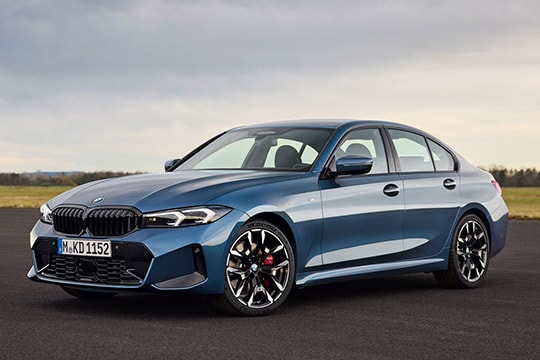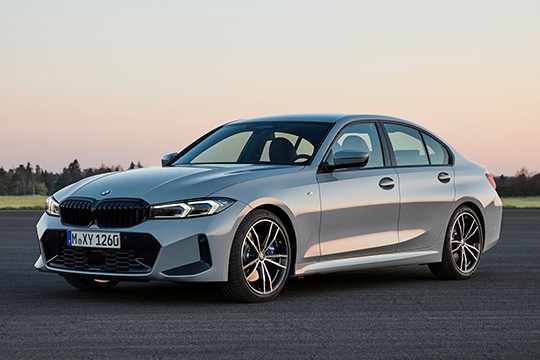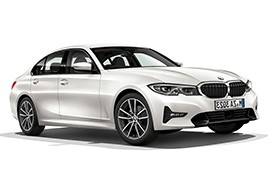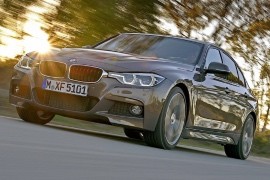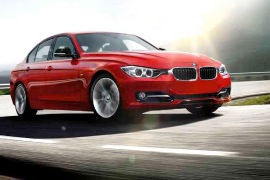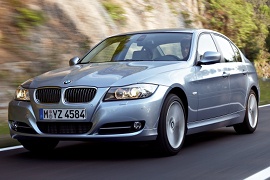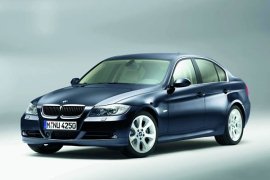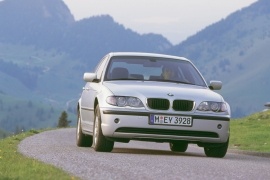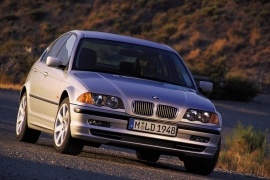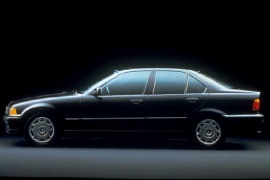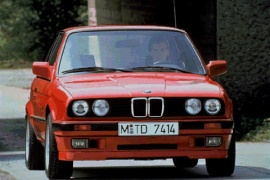BMW 3 Series Sedan Models/Series Timeline, Specifications & Photos
First production year: 1982
Engines: Mild hybrid diesel, Gasoline, Hybrid gasoline, Mild hybrid, Diesel, Hybrid
Usually, BMW had one facelift for each generation of its vehicles, and that’s why the automaker surprised everyone when it launched a second refresh for the 3 Series’ seventh sequel in 2024.
After almost half a century and more than 20 million units sold worldwide, the 3 Series was a successful story. The compact executive sedan had evolved from a humble two-door vehicle to a range of vehicles, including sedans, convertibles, coupes, and station wagons. Then, in 2014, the automaker split the range into the 3 Series and the 4 Series. The former nameplate remained in use for station wagons and sedans, while the latter was for convertibles and coupes with two or four doors. As a result, when BMW launched the seventh generation of the 3 Series in 2018, it offered it only as a four-door sedan or a station wagon. Then, in 2022, the automaker refreshed the lineup, so customers were expecting a completely new model for 2026. Surprisingly, though, in 2024, the German brand launched a second facelift for the G20 model. However, the car manufacturer preferred the Life Cycle Impulse (LCI for short) designation.
One of the most significant styling updates was for the headlights, which feature LEDs, adaptive LEDs, or Matrix-LEDs, depending on the grades. Along with this refreshed version, BMW phased away the already known “angel eyes” design theme represented by lit surroundings for the main beams and introduced comma-like elements for the daytime running lights. Between them, the 2025 3 Series sedan sported a redesigned, more angular-shaped, horizontal kidney grille. For the lower bumper, customers could choose between the standard, the M-Pack, and the M-Pack Pro packages. All of them featured a broad air intake in the middle and vertical side scoops for the air curtains that lowered the car’s drag coefficient. The former one had smaller vents, while the latter two were taller. In addition, the M-Pack Pro also added shiny black rims for the main grille instead of silver ones like the other two.
From its profile, the second refresh of the G20 Bimmer featured a long hood where an inline-six engine could easily fit. The flared wheel arches looked almost identical across the range, besides the mighty M3 versions. There were no significant updates to the vehicle’s overall design, albeit the automaker offered it with a choice of alloy wheels ranging between 17- and 19 inches. Out back, also depending on the grades, engines, and options, the automaker placed a black trapezoidal-shaped trim on the lower part of the bumper. In addition, sportier versions could be fitted with a broad diffuser flanked by side-mounted exhausts.
Inside, the automaker installed a curved display that united the instrument panel and the touchscreen for the infotainment system. Along with the 2025 BMW 3 Series Touring, the automaker introduced its newest BMW Operating System 8.5. This included augmented reality and new controls for the HVAC system, with touch sliders permanently kept in the same lower position of the infotainment screen. Customers could customize their vehicles with new M-badged steering wheels featuring a 12-o’clock mark. Besides the standard comfort seats, the 3 Series was available with a set of high-bolstered ones as well. On the center console, the car was available with different trims that surrounded the control panel for the buttons placed there for the automatic transmission, driving modes, and parking brake. In the back, the bench seat was wide enough for three occupants, but the tall transmission tunnel limited legroom for the one who sat in the middle.
BMW offered the 2025 3 Series Sedan with a choice of four gasoline and four diesel engines, all turbocharged and electrified using a 48-volt technology. Furthermore, the 330e plug-in version could work in EV mode only for around 101 km (63 miles), dramatically improving fuel efficiency without sacrificing comfort or performance. All engine versions were paired with an eight-speed automatic transmission with an integrated electric motor, which was very efficient for hybrid and mild-hybrid versions.
BMW sold more than a million units in just three years since the launch of the seventh generation of the 3 Series, and the German automaker tried to maintain its lead in the premium segment of this compact executive sedan.
With sales accounting for 14 percent of the automaker's entire lineup, the 3 Series was the family's cash cow. It was available in two shapes, sedan and Touring, since the Gran Turismo version was ditched due to slow sales. Furthermore, it didn't have a coupe or convertible in the lineup since those versions were rebadged as the 4 Series, which was introduced in 2013. But there was one certain thing: in just three years since the model's launch in 2019, the seventh generation of the 3 Series outsold any of its predecessors. Remember that all these happened despite the world pandemic and the following microchip crisis. In short, it was a beloved car not just by the brand's fans. It also attracted customers from other automakers, too. As a result, BMW tried to keep its sales figures up and quickly introduced a refreshed version in July 2022 for both body shapes.
At the front, the most striking news was the introduction of standard LED headlights. Thanks to this crucial update, the automaker could make them slimmer since they didn't have to accommodate bi-xenon brights as its predecessor. In addition, the daytime running lights have been modified and had a reversed L-shape. Due to these modifications, BMW had to redesign the kidney grille to look wider than before. In standard trim, the lower side of the bumper looked similar to its predecessor with its T-shaped side scoops, albeit the center air intake was broader. Customers could also opt for an M Pack, which added a more aggressive look for the apron, featuring a hexagonal wide air intake on the lower side flanked by L-shaped side scoops.
From its profile, there were no significant changes to the vehicle. Entry-level models were provided with 16-inch multi-spoke alloy wheels. At the same time, the higher grades were fitted with 18-inch wheels and fat tires. On the front fenders, the 2022 BMW 3 Series Sedan (G20 in factory coding) featured a sculptured lower area, which was continued on the door panels towards the back of the car. Like its non-facelifted version, the refreshed one had a short rear deck with an integrated duck tail in the trunk's lid. For the rear fascia, BMW prepared a fresh set of taillights that sported L-shaped lights for parking and braking, while the reversing ones were smaller and positioned on the upper area of the tail lamps. Lower, the automaker also provided a standard wrapped-around plastic bumper fitted with T-shapes echoing the ones from the front. In addition, the automaker also offered a more aggressive-looking bumper fitted with a large diffuser underneath it.
Inside, the technological package has been rich ever since the model's introduction in 2019. But still, that version lacked some amenities. The most noticeable upgrade was BMW's curved display, which combined the 12.3" instrument panel and the 14.9" screen for the infotainment system atop the dashboard featuring BMW Operation System 8. There was no instrument cluster anymore. Below, on the center console, the automaker installed a small switch for the gear selector instead of the golf-club-like shaped one as in the 2019 model year. Furthermore, there were additional options and trims, including brushed aluminum. BMW also said that it used more than 50% recycled materials for aluminum and about 16% for thermoplastics.
Under the hood, the automaker understood that the turbocharged three-cylinder engine had to go. Another improvement over its predecessor was the increased range of electrified drivetrains (mild hybrids that worked on the 48-volt architecture. Furthermore, BMW also added two plug-in hybrids in the lineup that provided 204 PS (201 hp) and 292 PS (288 hp), respectively.
The German automaker BMW introduced the seventh generation of the 3 Series in 2018, continuing its streak of successful models in the compact executive sedan segment.
BMW has produced over 15 million units of the 3 Series since the model's launch in 1975, and it was the family's money-maker. As a result, the carmaker had to meet its customers' high expectations for the G20, and they did it. It was a completely new vehicle that carried over just a few elements from its predecessor, the E90, and more from its bigger sibling, the 5 Series (G30), with which it shared its CLAR platform.
With a design that followed the idea of its predecessor, the 3 Series G20 featured narrow headlights and a slightly larger kidney grille. Besides the base models that featured bi-xenon headlights, the automaker offered a full-LED package with high-beam assist. Depending on the options and packages, the 2018 3 Series featured an elegant bumper with slim and horizontal air intake flanked by small scoops. Those who opted for the sports package got the car with a more aggressive stance featuring triangular-shaped air intakes that cooled the front brakes. From its profile, the long hood was followed by the greenhouse, which was extended towards the back of the vehicle in a cab-rearward design. Thanks to its short deck at the back, the 3 Series G20 offered a sporty look for its customers. The taillights were full-LEDs and were extended from the quarter panels to the trunk lid, thus improving the car's visibility from the rear. Under the bumper, the carmaker installed either one or two exhausts, depending on the engine version and options.
Inside, the automaker offered options for either a digital or an analog instrument cluster complemented by a screen for the infotainment system placed atop the center stack in a free-floating position. On the center tunnel that separated the front occupants, BMW installed the gear stick or the selector for the automatic transmission, several buttons for driving modes (ECO, comfort, sport), parking sensors, and an electric handbrake. In addition, the iDrive infotainment's system rotary dial was also housed there. Customers had the option to buy the car with either bucket seats or high-bolstered ones that provided better support during high-speed cornering. There was plenty of legroom for two passengers in the back on the split-folding bench seat, although the tall transmission tunnel limited comfort for a middle-seated one.
Under the hood, there was a wide range of diesel and gasoline powerplants mated with either a six-speed manual or an eight-speed automatic. Like in the previous generation, most versions could've been bought with either a rear- or an all-wheel-drive system. In addition, a plug-in hybrid system was on offer.
BMW 3 Series Sedan (G20) 318d 6MT (150 HP)
BMW 3 Series Sedan (G20) 318d 8AT (150 HP)
BMW 3 Series Sedan (G20) 320d 6MT (190 HP)
BMW 3 Series Sedan (G20) 320d 8AT (190 HP)
BMW 3 Series Sedan (G20) 320d 8AT (265 HP)
BMW 3 Series Sedan (G20) 320d xDrive 8AT AWD (190 HP)
BMW refreshed the sixth generation of the 3 Series in 2015 for the 2016 model year and introduced significant upgrades for one of its most important vehicles.
When the automaker introduced the sixth generation of the 3 Series Sedan, known as the F30 in factory coding, in 2011, it already knew that the new Euro 6 emission standards would follow. As a result, it prepared the car for that and waited for the right moment to introduce the changes. However, it seemed like the automaker didn’t have enough money left to spend on the design upgrades, and only a trained eye for detail could notice the differences between the initial 2011 model year and the facelifted 2015 one, albeit BMW didn’t call its refreshed models like that. It named them LCI, or Life Cycle Impulse. In terms of technology upgrades, that was true, but in terms of styling, not so.
At the front, the automaker introduced new LED headlights fitted with redesigned daytime running lights. In the initial model, these were round, while in the refreshed version, they were angular-shaped and underlined with high- and low-beam bulbs. It is worth noticing that the LCI version was the first 3 Series available with full-LED headlights. Another improvement was seen on the lower bumper, which received broader side scoops that integrated the available fog lamps. As an option, customers could get an M Sport Package, which added a different bumper featuring a broad center air intake in the apron flanked by angular-shaped side scoops.
The car’s profile showed the same look with a lean-forward stance. Furthermore, an ascending creased line ran along the bodywork from the front fenders to the taillights. For versions fitted with the M Sport Package, the automaker added a set of aerodynamic side skirts, which allegedly reduced ground effect. Customers could also opt for up to 18-inch light alloy wheels, while base models sported 16-inch ones. In the back, depending on the grade and options, the 2016 BMW 3 Series featured one or two pipes that poked from underneath the bumper. The latter variant was reserved for higher-powered versions, while the former was for turbodiesel and less potent engines.
Inside, there were no significant changes to the car at first sight. It had the same layout, seats, and door cards. Furthermore, even the center console was the same, albeit there was a new cover for the dual cup holders from the bottom of the center stack. However, there was a new infotainment system that could allow LTE data transfer. It also featured the Connected Drive service, which allowed customers to go over the Internet and find destinations and fastest routes. Thanks to the telematics system, the navigation unit was able to calculate routes according to traffic information. In addition, a concierge service allowed customers to ask a BMW representative about the closest points of interest.
While the exterior and interior changes were not that obvious, under its skin, the 2016 BMW 3 Series Sedan had significant improvements. For starters, the entry-level version featured an inline-three turbocharged gasoline engine, which was good news for fleet owners. Then, the former two-liter turbodiesel was replaced by a new one. Even though the new powerplant provided just six more ponies, it was better in fuel efficiency. Furthermore, the automaker started to replace most of the former N-family engines with the B-family ones for the turbocharged gasoline powerplants for both inline-four and inline-six units.
BMW 3 Series Sedan (F30) LCI 316d 6MT RWD (116 HP)
BMW 3 Series Sedan (F30) LCI 316d 8AT RWD (116 HP)
BMW 3 Series Sedan (F30) LCI 318 xDrive 6MT AWD (150 HP)
BMW 3 Series Sedan (F30) LCI 318d 6MT RWD (150 HP)
BMW 3 Series Sedan (F30) LCI 318d 8AT RWD (150 HP)
BMW 3 Series Sedan (F30) LCI 320d 6MT RWD (190 HP)
BMW 3 Series Sedan (F30) LCI 320d 8AT RWD (190 HP)
BMW 3 Series Sedan (F30) LCI 320d EfficientDynamics 6MT RWD (163 HP)
BMW 3 Series Sedan (F30) LCI 320d EfficientDynamics 8AT RWD (163 HP)
BMW 3 Series Sedan (F30) LCI 320d xDrive 8AT RWD (190 HP)
BMW 3 Series Sedan (F30) LCI 325d 6MT RWD (218 HP)
BMW 3 Series Sedan (F30) LCI 325d 8AT RWD (218 HP)
BMW 3 Series Sedan (F30) LCI 330d 8AT RWD (258 HP)
BMW 3 Series Sedan (F30) LCI 330d xDrive 8AT AWD (258 HP)
BMW 3 Series Sedan (F30) LCI 318i 6MT RWD (136 HP)
BMW 3 Series Sedan (F30) LCI 318i 8AT RWD (136 HP)
BMW 3 Series Sedan (F30) LCI 320i 6MT RWD (184 HP)
BMW 3 Series Sedan (F30) LCI 320i 8AT RWD (184 HP)
BMW 3 Series Sedan (F30) LCI 320i xDrive 6MT AWD (184 HP)
BMW 3 Series Sedan (F30) LCI 320i xDrive 8AT AWD (184 HP)
BMW 3 Series Sedan (F30) LCI 330i 6MT RWD (252 HP)
BMW 3 Series Sedan (F30) LCI 330i 8AT RWD (252 HP)
BMW 3 Series Sedan (F30) LCI 330i xDrive 8AT AWD (252 HP)
BMW 3 Series Sedan (F30) LCI 340i 6MT RWD (326 HP)
BMW 3 Series Sedan (F30) LCI 340i 8AT RWD (326 HP)
The sixth generation of the 3 Series broke cover in late 2011 as a 2012 model year, and, like its predecessors, it relied on a sporty driving experience and premium quality to convince its buyers.
BMW’s best-selling model, the 3 Series, was on the market since 1975, and while the first generation was available only as a two-door coupe, it evolved into a full range of products. In 2012, the 3 Series lost its coupe version, which became the 4 Series, but the four-door sedan remained one of the best vehicles made by the German automaker. The new generation came with a wider range of engines than its predecessor, offering not just diesel and gasoline powerplants but also a hybrid version, representing the start of the electrification era for this nameplate.
The sixth generation of this nameplate got the F30 internal designation and was the first 3 Series to ditch the E-XX coding system used for decades by BMW. The design and technology installed on this car were a leap forward compared to its predecessor, the E90. At the front, the automaker installed a pair of headlights that looked pinched on their inner side, towards the grille. The standard version of the car featured a lower bumper with a broad grille, with an option for round fog lamps. In addition, an M-package came with a different look, with broad air intakes that flanked a V-shaped lower grille. From its profile, the cab-rearward design was emphasized by the long hood and short rear deck. Furthermore, the crease along the bodywork started from the front fenders, ran along the door panels towards the rear quarter panels, and ended on the taillights. Depending on the engine version and options, the F30 featured single, double, or dual exhausts with one pipe on each side.
Inside, the cockpit was dominated by high-quality materials, even in the lowest grade, which was fitted with cloth seats. Still, customers could get sports bucket seats with high bolstered areas. Fronting the driver was a clean-designed instrument cluster with large dials for the speedometer and tachometer. BMW installed a screen for the iDrive infotainment system atop the center stack, above the center vents. Despite the long wheelbase of the vehicle, in the back, there was not too much legroom for adult-sized passengers due to the longitudinally mounted engine at the front and the tall transmission tunnel.
Under the hood, the automaker installed a wide choice of engines with three, four, and six cylinders, all turbocharged, both gasoline and diesel. Standard transmission for most of the range consisted of a six-speed manual, while an eight-speed automatic was available at extra cost. BMW offered the 3 Series with either rear or all-wheel-drive transmissions, depending on the options.
BMW 3 Series (F30) 316d 6MT RWD (116 HP)
BMW 3 Series (F30) 316d 8AT RWD (116 HP)
BMW 3 Series (F30) 318 xDrive 6MT AWD (143 HP)
BMW 3 Series (F30) 318d 6MT RWD (143 HP)
BMW 3 Series (F30) 318d 8AT RWD (143 HP)
BMW 3 Series (F30) 320d 6MT RWD (184 HP)
BMW 3 Series (F30) 320d 8AT RWD (184 HP)
BMW 3 Series (F30) 320d Efficient Dynamics 6MT RWD (163 HP)
BMW 3 Series (F30) 320d Efficient Dynamics 8AT RWD (163 HP)
BMW 3 Series (F30) 320d xDrive 6MT AWD (184 HP)
BMW 3 Series (F30) 320d xDrive 8AT AWD (184 HP)
BMW 3 Series (F30) 325d 6MT RWD (218 HP)
BMW 3 Series (F30) 328d 8AT RWD (184 HP)
BMW 3 Series (F30) 328d xDrive 8AT AWD (184 HP)
BMW 3 Series (F30) 330d 8AT RWD (258 HP)
BMW 3 Series (F30) 316i 6MT RWD (136 HP)
BMW 3 Series (F30) 316i 8AT RWD (136 HP)
BMW 3 Series (F30) 320i 6MT RWD (184 HP)
BMW 3 Series (F30) 320i 8AT RWD (184 HP)
BMW 3 Series (F30) 320i Efficient Dynamics Edition 6MT RWD (170 HP)
BMW 3 Series (F30) 320i Efficient Dynamics Edition 8AT RWD (170 HP)
BMW 3 Series (F30) 320i xDrive 6MT AWD (184 HP)
BMW 3 Series (F30) 320i xDrive 8AT AWD (184 HP)
BMW 3 Series (F30) 328i 6MT RWD (245 HP)
BMW 3 Series (F30) 328i 8AT RWD (245 HP)
BMW 3 Series (F30) 328i xDrive 6MT AWD (245 HP)
BMW 3 Series (F30) 328i xDrive 8AT AWD (245 HP)
BMW 3 Series (F30) 335i 6MT RWD (306 HP)
BMW 3 Series (F30) 335i 8AT RWD (306 HP)
With the Euro 5 emission standards approaching in Europe, BMW needed to upgrade its lineup, so in late 2008, the German automaker introduced the LCI version for the 3 Series range.
While some automakers just launched their new cars in 2008, which were already compliant with the Euro 5 emission standards, BMW needed only to improve the 3 Series via a facelift, or LCI as it likes to call it (Life Cycle Impulse). But it did more than that. It also adjusted the car’s exterior and interior before installing fresh engines under its hood. In addition, it also improved some parts that were not on par with the brand’s high-quality standards. The 3 Series sedan, which was the best-selling model in the automaker’s inventory, was unveiled in October 2008 alongside its station wagon sibling, also known as the Touring in Europe or Sports Wagon in the U.S.
The German automaker was already a master in creating subtle yet significant changes to the LCI versions of its vehicles. As a result, the 2009 BMW 3 Series Sedan (E90) appeared with new headlights featuring LED turn signals. In addition, customers could opt for bi-xenon lights, with corona rings (daytime running lights) that created a more upscale look to the vehicle. The redesigned kidney grille between them didn’t sport the chromed set of eyebrows above them like on its predecessor, and the hood was also new. In addition, for specific, higher-powered engine versions, the vertical slats inside the kidney grille were chromed, while the rest of the range had them black. These changes also affected the shape of the lower bumper, which sported reshaped lower air intakes with more rounded upper inner corners.
From its profile, the creased line that ran from the front fenders to the rear, over the doors, was emphasized to create a dynamic effect for the sporty sedan. New designs for the wheels, which ranged in size from 16 to 18 inches, made the car look young again. The door mirrors were also replaced, and they featured an enlarged field of vision, thanks to the convex/concave mirror systems. At the back, the 2009 BMW 3 Series Sedan (E90) had LEDs for the turn signal lamps and other lights. One of the most noticeable differences between the non-facelifted and the facelifted version was seen in the reversing lights, where the 2009 model year came with small-sized ones instead of the larger ones of its predecessor.
BMW also upgraded the interior of the 3 Series, especially the available iDrive infotainment system that featured an 8.8-inch high-quality display, so the images shown there didn’t appear blurry anymore. The system could also store up to 8 GB of music in its internal hard drive. Base versions, without that, allowed playing from USB devices such as memory sticks or MP3 players. The instrument cluster showed the classic BMW dials with the large speedometer and tachometer flanked by smaller gauges for the fuel level and coolant temperature.
Technically, the upgraded version of the E90 received the most important update. Under the hood, BMW installed a range of engines between 143 PS (141 hp) and 306 PS (302 hp) paired with six-speed manual or automatic transmissions that sent the power to the rear axle or in all corners for specific versions. To increase cornering abilities, the automaker also enlarged the rear track. Thanks to all these feats, the 3 Series Sedan (E90) sales didn’t drop too much during the financial crisis that started just a month before the car’s introduction.
BMW 3 Series (E90) 316d 6MT (115 HP)
BMW 3 Series (E90) 318d 6AT (143 HP)
BMW 3 Series (E90) 318d 6MT (143 HP)
BMW 3 Series (E90) 320d 6AT (177 HP)
BMW 3 Series (E90) 320d 6AT (184 HP)
BMW 3 Series (E90) 320d 6MT (177 HP)
BMW 3 Series (E90) 320d 6MT (184 HP)
BMW 3 Series (E90) 320d EfficientDynamics Edition 6MT (163 HP)
BMW 3 Series (E90) 320d xDrive 6AT (177 HP)
BMW 3 Series (E90) 320d xDrive 6AT (184 HP)
BMW 3 Series (E90) 320d xDrive 6MT (177 HP)
BMW 3 Series (E90) 320d xDrive 6MT (184 HP)
BMW 3 Series (E90) 325d 6AT (197 HP)
BMW 3 Series (E90) 325d 6AT (204 HP)
BMW 3 Series (E90) 325d 6MT (197 HP)
BMW 3 Series (E90) 325d 6MT (204 HP)
BMW 3 Series (E90) 330d 6AT (245 HP)
BMW 3 Series (E90) 330d 6MT (245 HP)
BMW 3 Series (E90) 318i 6AT (136 HP)
BMW 3 Series (E90) 318i 6AT (143 HP)
BMW 3 Series (E90) 318i 6MT (136 HP)
BMW 3 Series (E90) 318i 6MT (143 HP)
BMW 3 Series (E90) 320i 6AT (170 HP)
BMW 3 Series (E90) 320i 6MT (170 HP)
BMW 3 Series (E90) 325i 6AT (218 HP)
BMW 3 Series (E90) 325i 6MT (218 HP)
BMW 3 Series (E90) 325i xDrive 6AT (218 HP)
BMW 3 Series (E90) 325i xDrive 6MT (218 HP)
BMW 3 Series (E90) 330i 6AT (272 HP)
BMW 3 Series (E90) 330i 6MT (272 HP)
BMW 3 Series (E90) 330i xDrive 6AT (272 HP)
BMW 3 Series (E90) 330i xDrive 6MT (272 HP)
BMW 3 Series (E90) 335i 6AT (306 HP)
BMW 3 Series (E90) 335i 6MT (306 HP)
BMW introduced the fifth generation of the 3 Series at the 2005 Geneva Motor Show in March, and it shook the audience with its bold look that followed the design language imagined by Chris Bangle.
Creating a fresh design language for a brand that already had traditional styling was a challenging thing to do, and the person chosen by BMW to do that was the American designer, Chris Bangle. He started his work for the German automaker in 1999, so by 2002, when the first lines of the fifth generation of the 3 Series began to be drawn, his "Flame Surfacing" concept had already been implemented. Unfortunately, customers were not very delighted, to say the least, with the look of the 2001 7 Series (the E65/E66), the 2003 5 Series (the E60/E60), or the 2002 Z4 (the E85/E86). As a result, these vehicles had already polarized the market. With the 2005 3 Series, it was even more complicated since it was the company's best-selling vehicle. Chris Bangle assigned the sedan's design to the Japanese stylist Joji Nagashima, who was already known for his work on BMW after it penned the E39 BMW 5 Series. However, the new 3 Series, the E90, was a completely new challenge.
At the front, the car sported a more angular look than its predecessor, the E46, which was characterized by organic, fluid shapes. The new headlights were a mix of curved lines and sharp angles, especially in their rear area. They flanked a narrow kidney grille integrated into the front bumper. Visually, that was extended downward by an additional, trapezoidal-shaped air intake flanked by horizontal scoops with available round fog lamps.
The E90 3 Series was the first to pass the 4.5-meter mark, which was the standard for the European compact-sized vehicles. Its longer wheelbase than the one from its predecessor and increased overhangs led to a well-balanced design. As expected, the hood was still long enough to accommodate longitudinally-mounted inline-six powerplants. At the same time, the raked windshield was followed by an arched line for the roof adorned at the back by a shark-fin-like antenna for the infotainment system. At the back, the short deck was tall and ended with a small spoiler, which was part of the trunk's lid.
Inside, BMW installed higher-quality materials than on the E46, with bolstered or sports seats, depending on the grade and options. There were two types of dashboards, one without an iDrive unit and another with an integrated one. The former had a sleek line, while the latter showed a double hump design, where the one placed atop the center stack accommodated a color display for the infotainment system. Fronting the driver was a rounded instrument cluster featuring a classic layout for the automaker, with large dials for the speedometer and tachometer flanked by smaller gauges for the fuel level and coolant temperature. In addition, an LCD was placed underneath them, showing data from the car's onboard computer and the odometer. Between the front occupants, the automaker installed a center console that housed the gear stick, or the gear selector for the automatic transmission versions, an armrest with cubby storage underneath, and a small open storage area. There were no cup holders there, which annoyed some customers. Out back, the comfortable bench seat could accommodate three passengers, albeit the tall transmission tunnel drastically reduced legroom.
Under the hood, the 2005 3 Series E90 offered a wide choice of engines, with four or six cylinders, gasoline or turbodiesel. They were paired with six-speed manuals or automatics. BMW also offered the xDrive all-wheel drive systems for most inline-six versions.
BMW 3 Series (E90) 318d 6MT RWD (122 HP)
BMW 3 Series (E90) 318d 6MT RWD (143 HP)
BMW 3 Series (E90) 320d 6AT RWD (163 HP)
BMW 3 Series (E90) 320d 6AT RWD (177 HP)
BMW 3 Series (E90) 320d 6MT RWD (163 HP)
BMW 3 Series (E90) 320d 6MT RWD (177 HP)
BMW 3 Series (E90) 325d 6AT RWD (197 HP)
BMW 3 Series (E90) 325d 6MT RWD (197 HP)
BMW 3 Series (E90) 330d 6AT RWD (231 HP)
BMW 3 Series (E90) 330d 6MT RWD (231 HP)
BMW 3 Series (E90) 330xd 6AT RWD (231 HP)
BMW 3 Series (E90) 318i 6AT RWD (129 HP)
BMW 3 Series (E90) 318i 6AT RWD (143 HP)
BMW 3 Series (E90) 318i 6MT RWD (129 HP)
BMW 3 Series (E90) 318i 6MT RWD (143 HP)
BMW 3 Series (E90) 320i 6AT RWD (150 HP)
BMW 3 Series (E90) 320i 6AT RWD (170 HP)
BMW 3 Series (E90) 320i 6MT RWD (150 HP)
BMW 3 Series (E90) 320i 6MT RWD (170 HP)
BMW 3 Series (E90) 320si 6MT RWD (173 HP)
BMW 3 Series (E90) 323i 6MT RWD (177 HP)
BMW 3 Series (E90) 325i 6AT RWD (218 HP)
BMW 3 Series (E90) 325i 6MT RWD (218 HP)
BMW 3 Series (E90) 325xi 6AT AWD (218 HP)
BMW 3 Series (E90) 325xi 6MT AWD (218 HP)
BMW 3 Series (E90) 330i 6AT RWD (258 HP)
BMW 3 Series (E90) 330i 6AT RWD (272 HP)
BMW 3 Series (E90) 330i 6MT RWD (258 HP)
BMW 3 Series (E90) 330i 6MT RWD (272 HP)
BMW 3 Series (E90) 330xi 6AT AWD (258 HP)
BMW 3 Series (E90) 330xi 6AT AWD (272 HP)
BMW 3 Series (E90) 330xi 6MT AWD (258 HP)
BMW 3 Series (E90) 330xi 6MT AWD (272 HP)
BMW 3 Series (E90) 335i 6AT RWD (306 HP)
BMW 3 Series (E90) 335i 6MT RWD (306 HP)
BMW introduced a refreshed version for the fourth generation of the 3 Series in 2001 for the 2002 model year, and along with some exterior updates, it greatly improved the interior and the engine lineup.
When the German automaker launched the fourth generation of the 3 Series in late 1997 for the 1998 model year, it instantly became a sought-after vehicle. Customers already knew what the 3 represented and understood it would dominate the market segment. Even though it wasn’t such a significant aesthetic upgrade over the previous E36 lineup, it was still eye-catching enough to attract not just older customers but also new ones, even from other brands. Besides some mild exterior changes, the automaker dramatically improved the interior, offered new features, and added more safety systems. In addition, the drivetrains were heavily upgraded. The German automaker replaced almost the entire engine range, added new six-speed manual transmissions for selected versions, and made the all-wheel drive systems available for more powerplants.
At the front, customers noticed a new look for the car, which had everything new. There was a fresh set of headlights featuring wider double-curved lines on their lower area. In addition, Bi-Xenon lamps became available across the range, and they even had self-leveling systems. Between them, the automaker installed a new hood, which sported a broader kidney-grille design, regardless of the engine. Below, the automaker put a completely new bumper. It featured a broad trapezoidal-shaped slim air intake on the lower area, with angled-down outer edges. In the previous version, non-LCI, the 3 Series E46 featured angled-up, reversed-trapezoidal-shaped air intakes, like it was smiling.
There were no significant upgrades for the sporty-looking sedan. Thanks to its initial development, the car still looked classy with its long hood and cab-rearward design. But still, BMW considered improving it with redesigned front fenders to match the fresh headlights. It also offered chromed trims for a more luxurious look, depending on the market. In addition, base models were fitted with 16-inch alloy wheels with a few options for redesigned 17-inch sets. In the back, the most significant change was for the taillights, which sported either red or clear lenses over the turn signals, depending on the country. Furthermore, the bumper got a redesigned lower area with a broad black trim that could integrate the parking sensors.
Inside, the base versions featured the same cloth upholstery for all seats, but a leather-wrapped interior was available. Fronting the driver was an utterly new instrument panel. While it still featured the same large dials for the speedometer and tachometer flanked by smaller gauges for the fuel level and coolant temperature, it had new LCDs on the lower area showing data from the onboard computer. On the center stack, the automaker offered an option for a wider color screen for the navigation system, which replaced the previous one that showed only arrows for directions to follow. Furthermore, the center console received a new design, featuring a storage compartment with a retractable cover.
The 2002 BMW 3 Series sedan (E46) retained many underpinnings from the non-facelifted version, but it had significant changes for the drivetrain. Like its predecessor, the lineup had new engines with four and six cylinders. However, these were new and provided more power and improved fuel efficiency. In addition, more versions were available with all-wheel drive systems, including turbodiesel engines. The new three-liter powerplants received a six-speed manual instead of five like the rest of the range.
BMW 3 Series (E46) 316i 5AT RWD (115 HP)
BMW 3 Series (E46) 316i 5MT RWD (115 HP)
BMW 3 Series (E46) 318i 5AT RWD (143 HP)
BMW 3 Series (E46) 318i 5MT RWD (143 HP)
BMW 3 Series (E46) 320i 5AT RWD (170 HP)
BMW 3 Series (E46) 320i 5MT RWD (170 HP)
BMW 3 Series (E46) 325i 5AT RWD (192 HP)
BMW 3 Series (E46) 325i 5MT RWD (192 HP)
BMW 3 Series (E46) 330i 5AT RWD (231 HP)
BMW 3 Series (E46) 330i 5MT RWD (231 HP)
BMW 3 Series (E46) 330i 6MT RWD (231 HP)
BMW 3 Series (E46) 330xi 5AT AWD (231 HP)
BMW 3 Series (E46) 318d 5AT RWD (115 HP)
BMW 3 Series (E46) 318d 5MT RWD (115 HP)
BMW 3 Series (E46) 320d 5AT RWD (150 HP)
BMW 3 Series (E46) 320d 5MT RWD (150 HP)
BMW 3 Series (E46) 320d 6MT RWD (150 HP)
BMW 3 Series (E46) 330d 5AT RWD (184 HP)
BMW 3 Series (E46) 330d 5AT RWD (204 HP)
BMW 3 Series (E46) 330d 5MT RWD (184 HP)
BMW 3 Series (E46) 330d 6MT RWD (204 HP)
BMW 3 Series (E46) 330xd 5AT AWD (184 HP)
BMW 3 Series (E46) 330xd 5AT AWD (204 HP)
Some said BMW rushed a little when it launched the fourth generation of the 3 Series in November 1997, but its fans considered it about the right time.
With the fourth generation of the 3 Series, known as the E46 in factory coding, BMW made a significant step forward in the sports sedan compact executive segment. It was already a benchmark for its competitors and tried to stay there as long as possible but to achieve that, the carmaker had to adapt. And that’s precisely what it did with the E46. While some criticized the vehicle for not being as communicative to the driver as the E36, others praised it for its comfortable drive. It was an excellent mix between these two factors, and anyone could find the version most suitable for them. Furthermore, the introduction of highly efficient turbodiesel engines transformed the car into a long-range runner that could cover over 1,000 km (620 miles) on a single tank. In terms of design, it was not such a significant step forward.
With styling signed by the American designer Chris Bangle, the fourth generation of the 3 Series came with a revised front fascia that wasn’t as revolutionary as the previous generation. But still, the headlights featured more rounded lines, including a double curvature on their lower area. Like its predecessor, it featured corner-mounted turn signals that looked like they were part of the main headlamp unit, even though they weren’t. Between them, the car sported the already famous kidney grille, which was integrated into a 3 Series in the hood for the first time, not as a separate piece. Lower, on the apron, the automaker added a broad air intake placed in the apron, while a set of fog lamps were available and mounted above it, on the sides.
From its profile, the organic shapes of the 3 Series continued the bio-design trend, which was about to fade away from the industry. But still, it was a composed look, with the model’s specific long hood, a cabin pushed to the back, and a short deck behind it, like its predecessors. But still, there were more curved lines and shaved corners than on the E36. To make the car look more upscale, BMW introduced the body-colored door handles across the range. It also sat on bigger alloy wheels for the upper grades. All versions received aerodynamic side sills, contributing to the vehicle’s good fuel efficiency. At the back, the new corner-mounted taillights were taller and were extended on the trunk’s lid. Finally, on the lower side, the automaker installed a wrapped-around plastic bumper fitted with a rubber stripe that adorned it and protected it against small bumps.
Inside, even the base versions had features and amenities previously offered only as options, such as air conditioning. Drivers fronted a dashboard covered with soft-touch, high-quality materials, and the instrument cluster kept the half-circular visor above it, like on the E36, albeit more refined. BMW continued the tradition of creating a driver-oriented center stack, allowing better and easier control of the buttons. Starting with this generation, the 3 Series had the readings from the onboard computer shown in the instrument panel on a tiny display below the large dials for the speedometer and tachometer. Legroom was even better in the back than on the E36, but the thick front seats took some part of it.
From a technical point of view, the 1998 BMW 3 Series sedan (E46) was an important step forward. While the E36 was the first to feature an independent rear suspension, the fourth generation of this nameplate was available with more versions fitted with all-wheel drive systems. Under the hood, the automaker installed an unusually wide engine range, paired with either five- or six-speed manuals or five-speed automatics. In addition, depending on the version, the car had more nannies to keep the vehicle on the road than any of its predecessors, including a cornering braking system, a three-channel ABS, and stability control plus traction (ASC+T).
BMW 3 Series (E46) 316i 4AT RWD (105 HP)
BMW 3 Series (E46) 316i 5MT RWD (105 HP)
BMW 3 Series (E46) 318i 4AT RWD (118 HP)
BMW 3 Series (E46) 318i 5MT RWD (118 HP)
BMW 3 Series (E46) 320i 5AT RWD (170 HP)
BMW 3 Series (E46) 320i 5MT RWD (150 HP)
BMW 3 Series (E46) 320i 5MT RWD (170 HP)
BMW 3 Series (E46) 323i 5AT RWD (170 HP)
BMW 3 Series (E46) 323i 5MT RWD (170 HP)
BMW 3 Series (E46) 325i 5AT RWD (192 HP)
BMW 3 Series (E46) 325i 5MT RWD (192 HP)
BMW 3 Series (E46) 328i 5AT RWD (193 HP)
BMW 3 Series (E46) 328i 5MT RWD (193 HP)
BMW 3 Series (E46) 330i 5AT RWD (231 HP)
BMW 3 Series (E46) 330i 5MT RWD (231 HP)
The third generation of the 3 Series was the most significant revolution in the model’s history, not only until then but also for the other generations that followed.
It was challenging for the German automaker to replace such a beloved car as the 3 Series E30. Still, after nine years on the market and over two million units sold, it had to be replaced. Sales were slowing down, and customers wanted something more. That “more” was the 1991 3 Series or the E36 in the factory coding system. The E came from the “Evolution,” and the 36 was the project number. Like its predecessor, it was redesigned from the ground up, and it aimed to reach deeper pocket customers since it provided more of everything: comfort, power, agility, and features. The new model came on the market in 1991, while some versions of the E30 were still on sale. Despite that, the E36 sold well right off the bat, and it continued that way along the production run, exceeding 2.7 million units delivered worldwide, almost one million over its key competitor, the first generation of the Mercedes-Benz C-Class (W202). It was finally the premium compact sedan that BMW always wanted.
The car was penned by a team supervised by Claus Luthe, the same person who made the E30. Surprisingly, he ditched the idea of the quad-headlamps design of that successful model and created new ones with clear glass covering both the high and the low beams. In addition, the turn signals were corner-mounted as extensions to the headlights and were not placed lower like their predecessors. The design team also integrated the bumper neatly into the car’s shape, which was extended downwards by an apron where a pair of fog lamps were available. Another significant difference was for the reshaped kidney grille, which was wider.
From its profile, the 1991 BMW 3 Series (E36) sedan had curved, organic lines, which were part of the bio-design trend that had already started in the late ‘80s. That led to a taller nose, albeit not too much, followed by a panoramic windshield. Furthermore, the greenhouse wasn’t angular and sported shaved corners and a sloped rear window. At the back, the short and tall deck followed a slight descending line. Like in the previous generation, the E36 had steel wheels for the base model and alloy ones for the upper grades.
Inside, the curved dashboard sported a prominent center stack that looked like an extension of the instrument cluster. It was still tilted towards the driver and housed the integrated stereo at the top, followed by the HVAC and the available onboard computer. The center console was wide, and the automaker placed there the buttons for the power windows, when applicable, and the gear stick. In addition, between the front bucket seats, BMW put a small ashtray and the handbrake. In the back, thanks to the increased wheelbase compared to the E30, the E36 provided more room for up to three passengers that could sit on the bench seat, although the transmission tunnel was quite tall and limited legroom for the one seated in the middle.
Under the hood, BMW installed a fresh engine range, either gasoline or turbodiesel. The former was available exclusively with a fuel injection system. All versions sent their power to the rear wheels only via a five-speed manual or a four or five-speed automatic. Surprisingly, BMW didn’t make the E36 available with an all-wheel drive system, like the E30 325 iX.
BMW 3 Series Sedan (E36) 316i 4AT (102 HP)
BMW 3 Series Sedan (E36) 316i 4AT (99 HP)
BMW 3 Series Sedan (E36) 316i 5MT (102 HP)
BMW 3 Series Sedan (E36) 316i 5MT (99 HP)
BMW 3 Series Sedan (E36) 318i 4AT (115 HP)
BMW 3 Series Sedan (E36) 318i 5MT (115 HP)
BMW 3 Series Sedan (E36) 318is 4AT (140 HP)
BMW 3 Series Sedan (E36) 318is 5MT (140 HP)
BMW 3 Series Sedan (E36) 320i 5AT (150 HP)
BMW 3 Series Sedan (E36) 320i 5MT (150 HP)
BMW 3 Series Sedan (E36) 323i 5AT (170 HP)
BMW 3 Series Sedan (E36) 323i 5MT (170 HP)
BMW 3 Series Sedan (E36) 325i 5AT (192 HP)
BMW 3 Series Sedan (E36) 325i 5MT (192 HP)
Those who grew up in the ‘70s with a two-door 3 Series had already reached adulthood and wanted to continue with a Bimmer, although they needed a four-door sedan, so the automaker felt obliged to provide them with one.
While the 5 or the 7 Series from BMW were more expensive vehicles, the 1982 BMW 3 Series (E30) was still within reach for many. That convinced the German car manufacturer to create one on a fresh platform. The automaker carried over just a few engines from the previous generation, the E21, although with significant improvements. In addition, thanks to the upscale interior and inline-six engines, the E30 instantly became the benchmark for compact executive sports sedans. Furthermore, since the car had the exact wheelbase as its two-door sibling, it was as sporty and nimble as the coupe. Fathers had the sporty sedans of their teenage years.
The car’s look was signed by Claus Luthe, who was one of the most influential car stylists after WWII in Europe. Before moving to BMW, He was known for his work for NSU and Volkswagen. He took inspiration from the inline-six versions of the E21 3 Series with twin headlights design. Unlike that model, the second generation of the 3 Series didn’t have the same shark nose but a vertical front fascia. But still, he retained the horizontal lines of the grille, interrupted in the middle by BMW’s kidney grille. Below, the E30 had a metallic bumper with integrated turn signals and parking lights, while at the lower side, it sported an apron that reduced the ground effect.
With a simple and clean design for the profile but still keeping the Hofmeister-kink element of the C-posts, the second generation of the E30 was instantly recognizable. Depending on engine version, trims, and options, it rode on 14-inch steel or alloy wheels, with full-size plastic caps for the former and a turbine-like styling for the latter. Luthe created an ascending waistline for the vehicle and ended it with a short, flat, and straight deck instead of the sloped-down one as the previous generation of this moniker. In the back, the corner-mounted taillights featured inner-positioned tall reversing lights above the chromed metallic bumper. Depending on the engine, the car had a single or twin exhaust with both pipes on the same side, unlike the 323 E21, which had one on each side.
Inside, there were a plethora of options to choose from. In basic shape, the car came equipped with cranked windows, a stereo, and a simple ventilation system. On the other hand, buyers could opt for power windows for all four doors and a power moonroof. The dashboard featured a center stack that was obviously tilted towards the driver, helping the one behind the wheel to easily control the buttons placed there. The steering wheel fronted an instrument cluster with all the needed dials and gauges, such as the tachometer, the speedometer, and the gauges for the fuel level and coolant temperature. In addition, BMW placed a fuel-consumption meter below the rev counter, which was essential for those who want to save money on fuel. As an option, the German automaker installed a primitive version of an onboard computer that showed data about fuel efficiency, average speed, time traveled, and exterior temperature. The base versions of the car were fitted with cloth upholstery for the bucket seats up front and the rear bench seat, while higher grades could be optioned with leather upholstery on high-bolstered seats for the driver and their side passenger and also for those seated in the back.
BMW took just some of the engines from the previous generation of the 3 Series, but it improved them dramatically to perform better, provide more power, or offer increased fuel efficiency. All versions, regardless of engine power or trims, were paired with a five-speed manual as standard, while a three- or four-speed automatic was available for specific versions. Power went to the rear wheels only, and a mechanical self-locking differential was available.
BMW 3 Series Sedan (E30) 316 4AT RWD (90 HP)
BMW 3 Series Sedan (E30) 316 5MT RWD (90 HP)
BMW 3 Series Sedan (E30) 316i 4AT RWD (102 HP)
BMW 3 Series Sedan (E30) 316i 4AT RWD (99 HP)
BMW 3 Series Sedan (E30) 316i 5MT RWD (102 HP)
BMW 3 Series Sedan (E30) 316i 5MT RWD (99 HP)
BMW 3 Series Sedan (E30) 318i 4AT RWD (105 HP)
BMW 3 Series Sedan (E30) 318i 4AT RWD (113 HP)
BMW 3 Series Sedan (E30) 318i 5MT RWD (105 HP)
BMW 3 Series Sedan (E30) 318i 5MT RWD (113 HP)
BMW 3 Series Sedan (E30) 320i 4AT RWD (125 HP)
BMW 3 Series Sedan (E30) 320i 4AT RWD (129 HP)
BMW 3 Series Sedan (E30) 320i 5MT RWD (125 HP)
BMW 3 Series Sedan (E30) 320i 5MT RWD (129 HP)
BMW 3 Series Sedan (E30) 323i 4AT RWD (150 HP)
BMW 3 Series Sedan (E30) 323i 5MT RWD (150 HP)
BMW 3 Series Sedan (E30) 325e 4AT RWD (129 HP)
BMW 3 Series Sedan (E30) 325e 5MT RWD (129 HP)
BMW 3 Series Sedan (E30) 325i 4AT RWD (170 HP)
BMW 3 Series Sedan (E30) 325i 5MT RWD (170 HP)
